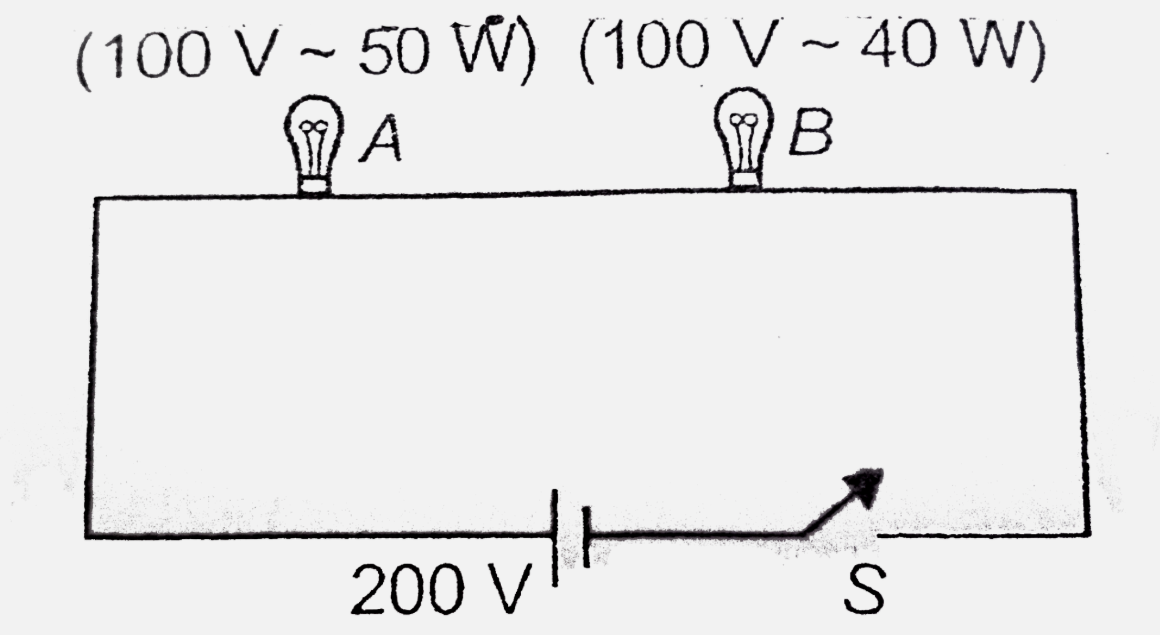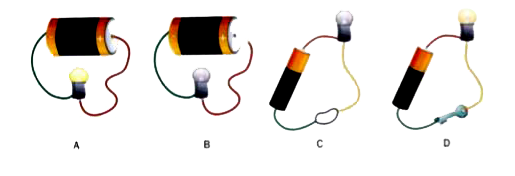Two sets A and B, of three bulbs each, are glowing in two separate rooms. When one of the bulbs in set A is fused, the other two bulbs also cease to glow. But in set B, when one bulb fuses, the other two bulbs continue to glow. Why do we prefer arrangements of Set B for house circuiting?
To understand why we prefer the arrangement of Set B for house circuiting, we need to analyze the two different configurations of the bulbs: series and parallel.
1. Identify the Bulb Sets: We have two sets of bulbs, Set A and Set B, each containing three bulbs.
2. Analyze Set A: In Set A, when one bulb fuses (breaks), the other two bulbs also stop glowing. This indicates that all bulbs are connected in a series circuit. In a series circuit, the current flows through each bulb one after the other. If one bulb fails (fuses), it breaks the circuit, and no current can flow, causing all bulbs to go out.
3. Analyze Set B: In Set B, when one bulb fuses, the other two bulbs continue to glow. This indicates that the bulbs are connected in a parallel circuit. In a parallel circuit, each bulb has its own separate path for the current. Therefore, if one bulb fails, the current can still flow through the other bulbs, allowing them to remain lit.
4. Comparison of Series and Parallel Circuits:
- In a series circuit (like Set A), all components are dependent on each other. If one fails, the entire circuit fails.
- In a parallel circuit (like Set B), each component operates independently. The failure of one does not affect the others.
5. Preference for Parallel Arrangement: We prefer the parallel arrangement for house circuiting because:
- It allows for individual control of each bulb. You can turn one bulb off without affecting the others.
- If one bulb fails, it does not disrupt the operation of the other bulbs, ensuring continuous lighting in the house.
- It provides greater reliability and convenience in household electrical systems.
Conclusion:
Thus, the arrangement of Set B (parallel circuit) is preferred for house circuiting due to its independent operation of bulbs, which enhances reliability and control.
- In a series circuit (like Set A), all components are dependent on each other. If one fails, the entire circuit fails.
- In a parallel circuit (like Set B), each component operates independently. The failure of one does not affect the others.
- It allows for individual control of each bulb. You can turn one bulb off without affecting the others.
- If one bulb fails, it does not disrupt the operation of the other bulbs, ensuring continuous lighting in the house.
- It provides greater reliability and convenience in household electrical systems.
Thus, the arrangement of Set B (parallel circuit) is preferred for house circuiting due to its independent operation of bulbs, which enhances reliability and control.
Topper's Solved these Questions
Similar Questions
Two sets A and B, of three bulbs each, are glowing in two separate rooms. When one of the bulbs in set A is fused, the other two bulbs also cease to glow. But in set B, when one bulb fuses, the other two bulbs continue to glow. Explain why this phenomenon occurs.
View SolutionTwo sets A and B each of four bulbs are glowing in two separate rooms. When one of the bulbs in set A is fused, the other three bulbs also cease to glow. But in set B, when one bulb fuses, the other bulbs continue to glow. (i) Explain the difference in the two sets. (ii) Which set of arrangement is preferred in housing circuit and why ?
View SolutionIn the above example, if we join the bulbs in parallel and 300 V is applied, which of the two bulbs will fuse?
View SolutionTwo electric bulbs have tungsten filament of same length. If one of them gives 60W and the other 100W , then
View SolutionThree incandecent bulbs of 100W each are connected in series in an electric circuit. In another circuit another set of three bulbs of the same wattage are connected in parallel to the same source.
(a) Will the bulbs in the two circuits glow with the same brightness ? Justify your answer.
(b) Now let one bulb in both the circuits get fused. Will the rest of the bulbs continue to glow in each circuit ? Give reason.
View SolutionOf the bulbs in a house, one glows brighter than the other, which of the two has a large resistance.
View SolutionTwo bulbs A and B are connected as shown . When switch 'S' is closed then which of them will fuse?

View SolutionThe tungsten filaments of two electric bulbs are of the same length. If one of them gives 25 W power and the other 60 W power, then
View SolutionIn the following figures, the bulbs in Figure A and D glow, but the bulbs in Figure B and C do not glow. Give reason.

View SolutionTwo bulbs A and B of equal capacity are filled with He and SO2, respectively, at the same temperature.
(a) If the pressures in the two bulbs are same, what will be the ratio of the velocities of the molecules of the two gases?
View Solution